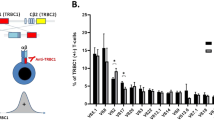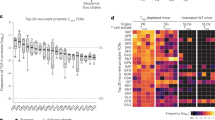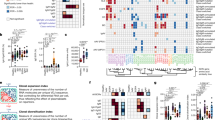Abstract
Primary infection with Epstein–Barr virus often results in the clinical syndrome of acute infectious mononucleosis (glandular fever). This illness is characterized by a striking lymphocytosis, the nature of which has been controversial. We show that large monoclonal or oligoclonal populations of CD8+ T cells account for a significant proportion of the lymphocytosis and provide molecular evidence that these populations have been driven by antigen. The results suggest that the selective and massive expansion of a few dominant clones of CD8+ T cells is an important feature of the primary response to this virus.
This is a preview of subscription content, access via your institution
Access options
Subscribe to this journal
Receive 12 print issues and online access
$209.00 per year
only $17.42 per issue
Buy this article
- Purchase on Springer Link
- Instant access to full article PDF
Prices may be subject to local taxes which are calculated during checkout
Similar content being viewed by others
References
Masucci, M.G. & Ernberg, I. Epstein-Barr virus: Adaptation to a life within the immune system. Trends Microbiol. 2, 125–130 (1994).
Venkitaraman, A.M., Lenoir, G. & John, T.J. The seroepidemiology of infection due to Epstein-Barr virus in southern India. J. Med. Virol. 15, 11–16 (1985).
Lai, P.K., Mackay-Scollay, E.M. & Alpers, M.P. Epidemiological studies of Epstein-Barr herpesvirus infection in Western Australia. J. Hyg. Lond. 74, 329–337 (1975).
Hesse, J., Ibsen, K.K., Krabbe, S. & Uldall, P. Prevalence of antibodies to Epstein-Barr virus (EBV) in childhood and adolescence in Denmark. Scand. J. Infect. Dis. 15, 335–338 (1983).
Niedobitek, G. & Young, L.S. Epstein-Barr virus persistence and virus-associated tumours. Lancet 343, 333–335 (1994).
Murray, R.J. et al. Identification of target antigens for the human cytotoxic T cell response to Epstein-Barr virus (EBV): Implications for the immune control of EBV-positive malignancies. J. Exp. Med. 176, 157–168 (1992).
Strang, G. & Rickinson, A.B. Multiple HLA class I-dependent cytotoxicities constitute the “non-HLA-restricted” response in infectious mononucleosis. Eur. J. Immunol. 17, 1007–1013 (1987).
Rooney, C.M. et al. Use of gene-modified virus-specific T lymphocytes to control Epstein Barr virus related lymphoproliferation. Lancet 345, 9–13 (1995).
Tomkinson, B.E., Wagner, D.K., Nelson, D.L. & Sullivan, J.L. Activated lymphocytes during acute Epstein-Barr virus infection. J. Immunol. 139, 3802–3807 (1987).
Smith, T.J., Terada, N., Robinson, C.C. & Gelfand, E.W. Acute infectious mononucleosis stimulates the selective expression/expansion of Vβ6. 1-3 and Vβ7 T cells. Blood 81, 1521–1526 (1993).
Hingorani, R. et al. Clonal predominance of T cell receptors within the CD8+ CD45RO+ subset in normal human subjects. J. Immunol. 151, 5762–5769 (1993).
Posnett, D.M., Sinha, R., Kabak, S. & Russo, C. Clonal populations of T cells in normal elderly humans: The T cell equivalent to “benign monoclonal gammopathy”. J. Exp. Med. 179, 609–618 (1994).
Morley, J.K., Batliwalla, F.M., Hingorani, R. & Gregersen, P.K. Oglioclonal CD8+ T cells are preferentially expanded in the CD57+ subset. J. Immunol. 154, 6182–6190 (1995).
Davis, M.M. & Bjorkman, P.J. T-cell antigen receptor genes and T-cell recognition. Nature 334, 395–402 (1988).
McHeyzer-Williams, M.G. & Davis, M.M. Antigen-specific development of primary and memory T cells in vivo. Science 268, 106–111 (1995).
Lehner, P.J. et al. Human HLA-0201-restricted cytotoxic T lymphocyte recognition of influenza A is dominated by T cells bearing the Vβ17 gene segment. J. Exp. Med. 181, 79–91 (1995).
Callan, M.F.C. et al. Selection of T cell receptor variable gene-encoded amino acids on the third binding site loop: A factor influencing variable chain selection in a T cell response. Eur. J. Immunol. 25, 1529–1534 (1995).
Siu, G., Strauss, E.C., Lai, E. & Hood, L.E. Analysis of a human Vβ gene subfamily. J. Exp. Med. 164, 1600–1614 (1986).
Ferradini, L. et al. Studies on the human T cell receptor α/β variable region genes II. Identification of four additional Vβ subfamilies. Eur. J. Immunol. 21, 935–942 (1991).
Kimura, N., Toyonaga, B., Yoshikai, Y., Du, R.-P. & Mak, T.W. Sequences and repertoire of the human T cell receptor α and β chain variable region genes in thymocytes. Eur. J. Immunol. 17, 375–384 (1987).
Concannon, P., Pickering, L.A., Kung, P. & Hood, L. Diversity and structure of human T-cell receptor β-chain variable region genes. Proc. Natl. Acad. Sci. USA 83, 6598–6602 (1986).
Argaet, V.P. et al. Dominant selection of an invariant T cell antigen receptor in response to persistent infection by Epstein Barr Virus. J. Exp. Med. 180, 2335–2340 (1994).
Li, Y., Szabo, P. & Posnett, D.N. The genomic structure of human Vβ6 T cell antigen receptor BV6 sequences. J. Exp. Med. 174, 1537–1548 (1991).
Pantaleo, B. et al. Major expansion of CD8+ T cells with a predominant Vβ usage during the primary immune response to HIV. Nature 370, 463–467 (1994).
Chen, Z.W. et al. T cell receptor Vβ-repertoire in an acute infection of rhesus monkeys with simian immunodeficiency viruses and a chimeric simian-human immunodeficiency virus. J. Exp. Med. 182, 21–31 (1995).
Maryanski, J. et al. Single-cell PCR analysis of TCR repertoires selected by antigen in vivo: A high magnitude CD8 response is comprised of very few clones. Immunity 4, 47–55 (1996).
Uehara, T. et al. Apoptotic cell death of primed CD45RO+ T lymphocytes in Epstein Barr virus induced infectious mononucleosis. Blood 80, 452–458 (1992).
Carmichael, A., Jin, X., Sissons, P. & Borysiewicz, L. Quantitative analysis of the human immunodeficiency virus type 1 (HlV-1)-specific cytotoxic T lymphocyte response at different stages of HIV 1 infection: differential CTL responses to HIV 1 and Epstein-Barr virus in late disease. J. Exp. Med. 177, 249–256 (1993).
Moskophidis, D., Lechner, F., Pircher, H. & Zinkernagel, R.M. Virus persistence in acutely infected immunocompetent mice by exhaustion of antiviral cytotoxic effector T cells. Nature 362, 758–761 (1993).
Moskophidis, D., Laine, E. & Zinkernagel, R.M. Peripheral clonal deletion of antiviral memory CD8+ T cells. Eur. J. Immunol. 23, 3306–3311 (1993).
Clarke, G.R., Reyburn, H.T., Lancaster, F.C. & Boylston, A.W. Bimodal distribution of Vβ2+CD4+ T cells in human peripheral blood. Eur. J. Immunol. 24, 837–842 (1994).
Viney, L.J., Prosser, H.M., Hewitt, C.R.A., Lamb, J.R. & Owen, M.J. Generation of monoclonal antibodies against a human T cell receptor β chain expressed in transgenic mice. Hybridoma 11, 701–713 (1992).
Diu, A. et al. Fine specificity of monoclonal antibodies directed at human TCR variable regions: Comparison with oligonucleotide driven amplification for evaluation of V beta expression. Eur. J. Immunol. 23, 1422–1429 (1992).
Carrel, S. et al. Expression on human thymocytes of the idiotypic structures (Ti) from two leukaemia T cell lines Jurkat and HPB-ALL. Eur. J. Immunol. 16, 649–652 (1986).
Callan, M.F.C. et al. A method for producing monoclonal antibodies to human TCR beta chain variable regions. Proc. Natl. Acad. Sci. USA 90, 10454–10458 (1993).
Dellabona, P., Padovan, E., Casorati, G., Brockhaus, M. & Lanzavecchia, A. An invariant V alpha 24 J alpha Q/V beta 11 TCR is expressed in all individuals by clonally expanded CD4−CD8− T cells. J. Exp. Med. 180, 1171–1176 (1994).
Choi, Y. et al. A method for production of antibodies to human T cell receptor beta chain regions. Proc. Natl. Acad. Sci. USA 88, 8357–8361 (1991).
Mackensen, A. et al. Direct evidence to support the immunosurveillance concept in a human regressive melanoma. J. Clin. Invest. 98, 1397–1402 (1994).
Romagne, F., Besnardeau, L. & Malissen, B. A versatile method to produce antibodies to human T cell receptor V beta segments: Frequency determination of human V beta 2+ cells that react with toxic shock syndrome toxin-1. Eur. J. Immunol. 22, 2749–2752 (1992).
Choi, Y. et al. Interaction of Staphylococcus aureus toxin “superantigens” with human T cells. Proc. Natl. Acad. Sci. USA 86, 8941–8945 (1989).
Browning, M.J. et al. Tissue typing the HLA-A locus from genomic DNA by sequence-specific PCR: Comparison of HLA genotype and surface expression on colorectal tumor cell lines. Proc. Natl. Acad. Sci. USA 90, 2842–2845 (1993).
Sadler, A.M. et al. Low-resolution DNA typing for HLA-B using sequence-specific primers in allele- or group-specific ARMS/PCR. Tissue Antigens 44, 148–154 (1994).
Lee, S.P. et al. HLA 2.1 restricted cytotoxic T cells recognising a range of Epstein-Barr virus isolates through a defined epitope in latent membrane protein LMP2. J. Virol. 67, 7428–7435 (1993).
Author information
Authors and Affiliations
Rights and permissions
About this article
Cite this article
Callan, M., Steven, N., Krausa, P. et al. Large clonal expansions of CD8+ T cells in acute infectious mononucleosis. Nat Med 2, 906–911 (1996). https://doi.org/10.1038/nm0896-906
Received:
Accepted:
Issue Date:
DOI: https://doi.org/10.1038/nm0896-906
This article is cited by
-
Comparison of T-cell receptor diversity of people with myalgic encephalomyelitis versus controls
BMC Research Notes (2024)
-
T-large granular lymphocyte frequencies and correlates in disease states detected by multiparameter flow cytometry in pediatric and young adult population
Annals of Hematology (2024)
-
The immune synapses reveal aberrant functions of CD8 T cells during chronic HIV infection
Nature Communications (2022)
-
Somatic mutations in lymphocytes in patients with immune-mediated aplastic anemia
Leukemia (2021)
-
Nodal EBV-positive polymorphic B cell lymphoproliferative disorder with plasma cell differentiation: clinicopathological analysis of five cases
Virchows Archiv (2021)



